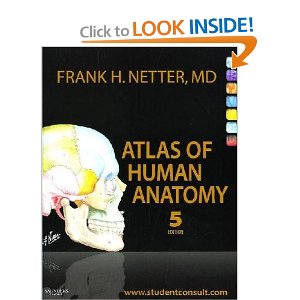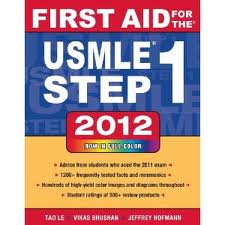This list is part of a series of articles about the best books for medical students. Click on the Med School Books Main Page to see other lists including the best books for each year in medical school, the best books for each clinical rotation, and the best books for USMLE Steps 1, 2, and 3.
This list of books was specifically created to help medical students. However, I would suggest the same books to anyone taking an undergraduate course in anatomy, to dental students, optometry students, podiatry students, physicians assistant students, advanced nursing students, etc. etc. When you are studying anatomy there are a few things you have to focus on: 1- Learning the name and location of the structures, 2- learning to identify the important anatomic relationships in the body, and 3- learning the clinical correlations related to the important relationships. Your tests will focus on each of these areas, so you must focus on them as well.
1. An Atlas:
Your first goal when starting your anatomy class will be to find the atlas that will help you learn. I created a separate list of the best available anatomy atlases a few months ago. I am partial to Netter's because I like bright colors, but each atlas has its own advantages and disadvantages. Below are a few links to the best known atlases. because I like bright colors, but each atlas has its own advantages and disadvantages. Below are a few links to the best known atlases.
Grant’s Atlas of Anatomy
Gray's Anatomy 
Clemente’s Anatomy
Rohen’s Color Atlas of Anatomy
|
|
2. An Anatomy Textbook:
An atlas is essential for learning WHERE anatomy is, but you must also learn WHY anatomy relationships are important; you will be tested on both paradigms. An anatomy textbook will teach you the pertinent anatomical/clinical relationships. I prefer Clinically Oriented Anatomy because it is brief and very high yield. I have also heard good things about Saladin Anatomy and Physiology because it is brief and very high yield. I have also heard good things about Saladin Anatomy and Physiology . .
|
|
3. A Dissector:
A 'dissector' is a manual that will guide you through dissection in the anatomy lab. Your class will likely suggest a specific book for the lab itself. Let me also recommend purchasing an extra copy from which to study. Grant's Dissector  works just fine. You will want to know all the important structures that you dissected, but you will NOT want to study out of your anatomy lab book! Gross. works just fine. You will want to know all the important structures that you dissected, but you will NOT want to study out of your anatomy lab book! Gross.
|
|
4. Flashcards:
To do well in an anatomy class you do not need to think, you only need to memorize. Flashcards are a must. Use them on the bus, trains, waiting in line, brushing your teeth, etc. Don't waste time making your own, you can buy a used box of beautiful flashcards for around $15. Again, my favorite are the Netter's Anatomy Flash Cards , they are bright and color coated for easy memorization. , they are bright and color coated for easy memorization.
As an aside, I have heard of a few people using 'coloring books' to study for anatomy. This actually sounds intriguing to me and I wish I heard about it earlier. Many companies make these books, here is a link to Netter's Anatomy Coloring Book . .
|
|
5. Anatomy Review Book:
I have raved about the BRS Series of review books before and I will again. The BRS Gross Anatomy  review is concise (albeit 500 pages) and high yield review of everything to do with anatomy and its clinical correlations. The best book for high yield review, however, is likely the First Aid for the Basic Sciences, General Principles review is concise (albeit 500 pages) and high yield review of everything to do with anatomy and its clinical correlations. The best book for high yield review, however, is likely the First Aid for the Basic Sciences, General Principles . This will include review of many other subjects, but it is very high yield and a fantastic resource. . This will include review of many other subjects, but it is very high yield and a fantastic resource.
|
|
6. Other Books:
Depending on the course structure, you may also be required to learn embryology and histology during your anatomy class. If so, let me suggest Langman's Medical Embryology and Ross Histology Text and Ross Histology Text  . .
|
|
GOOD LUCK!








 My name is Andrew and I am a first year resident training to be an ophthalmologist. I created ShortWhiteCoats to provide medical students, residents, and the public with all the information I spent so many hours looking for during medical school.
My name is Andrew and I am a first year resident training to be an ophthalmologist. I created ShortWhiteCoats to provide medical students, residents, and the public with all the information I spent so many hours looking for during medical school.









2 comments
Ahsan Mir
January 4, 2013 at 2:35 pm (UTC -4) Link to this comment
Thanks for these! Taking some undergrad classes in Anatomy before med school and these will definitely be invaluable. I decided on Rohen's Atlas and Netter's flashcards along with Moore's Essential Clinical Anatomy (Baby Moore) for some preliminary studying.
I'd also like to recommend an awesome app called 'Visible Body' (I have it for iphone but there's an iPad version as well). I use it constantly when I just can't remember the name of something or other. it presents the human body in a 3D image in which you can fade and hide muscles, arteries, veins, nerves, etc. and comes with descriptions about origin/insertion and function for almost everything, got it for $10 a while back now they have an improved version for $29.99 in the appstore, haven't used that one yet since I'm happy with the one I have but probably well worth the purchase as well for those times you just forgot the Netter cards at home :^)
Keep up the great work!
worried about anatomy
May 16, 2013 at 2:01 pm (UTC -4) Link to this comment
is snell's anatomy any good??? i have been studying gross from R.J last and don't get a thing!